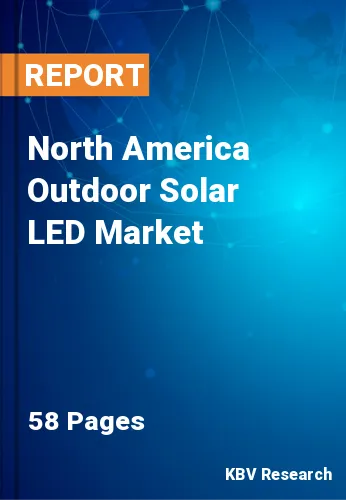The North America Outdoor Solar LED Market would witness market growth of 23.2% CAGR during the forecast period (2022-2028).
Solar adoption would considerably cut sulfur dioxide, nitrous oxides, and health-harmful pollutants, decreasing pollution and landscape degradation caused by drilling and fracking, as per research conducted by the National Renewable Energy Laboratory (NREL). The quantity of CO2 emitted by all of the street lights in the United States is equal to the annual emissions of 26 million cars. Pollution has an impact on humans in more ways than people think, yet solar energy is far healthier for the environment and public health.
One of the most appealing features of outdoor solar led lights is their low cost. Most solar-led garden lamps are DIY, so there are no costly installation expenses, and they provide adequate general lighting. Many solar-powered lights now have a Passive Infrared Sensor, which is an electrical sensor that detects and measures infrared light. The sensor detects variations in light and, at dusk, detects the lowering of the light, turning on the light; in morning, when the surrounding level of light increases, it turns off the light, saving the battery life.
Solar energy is now more affordable, accessible, and prevalent in the United States than it's ever been. In the United States, solar power capacity has increased from 0.34 GW in 2008 to almost 97.2 GW presently. This quantity of energy is sufficient to power 18 million average American homes. Solar energy, in the form of solar photovoltaics (PV) and concentrated solar-thermal power, now accounts for more than 3% of all electricity generated in the US (CSP).
Since 2014, the average cost of solar PV panels has dropped by almost 70%. Solar energy markets are rapidly expanding across the country, owing to the fact that in most jurisdictions, solar energy is already cost-competitive with conventional energy sources. In terms of cumulative and annual PV installations, the United States was the second-largest market in 2019. Furthermore, the country's total installed PV capability was 74.84 GW in 2019, with the utility industry accounting for 61.05 percent.
Polluting coal-fired power plants provide more than half of the electricity in the United States. The single largest primary source of high-temperature gas is power plants. Fortunately, alternative energy sources such as solar, breeze, geothermal, and hydro are gaining popularity among people. The easy adoption and installation of the outdoor solar led lights in this region, propel the growth of the market.
The US market dominated the North America Outdoor Solar LED Market by Country in 2021, and would continue to be a dominant market till 2028; thereby, achieving a market value of $3,849.2 million by 2028. The Canada market is anticipated to grow at a CAGR of 26% during (2022 - 2028). Additionally, The Mexico market would showcase a CAGR of 24.9% during (2022 - 2028).
Based on Application, the market is segmented into Street Lights, Garden Lights, Floodlights, Area Lights, and Spot Lights. Based on End Use, the market is segmented into Commercial, Residential, and Industrial. Based on Wattage, the market is segmented into 40W to 149W, Less than 39W, and More than 150W. Based on countries, the market is segmented into U.S., Mexico, Canada, and Rest of North America.
Free Valuable Insights: The Global Outdoor Solar LED Market is Estimated to reach $19.8 Billion by 2028, at a CAGR of 23.5%
The market research report covers the analysis of key stake holders of the market. Key companies profiled in the report include Greenshine New Energy LLC, Jiawei Renewable Energy Co. Ltd., Leadsun, SBM NewTech Co., Ltd., Solar Electric Power Company, Signify N.V., Jiangsu Sokoyo Solar Lighting Co., Ltd., Solar Street Lights USA, and Sunna Design SA.
By Application
By End Use
By Wattage
By Country
Our team of dedicated experts can provide you with attractive expansion opportunities for your business.

